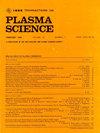Simulation of a 1-THz Complex Cavity Gyrotron With a Magnetic Cusp Gun
IF 1.3
4区 物理与天体物理
Q3 PHYSICS, FLUIDS & PLASMAS
引用次数: 0
Abstract
In this article, a 1-THz fourth harmonic complex cavity gyrotron with the magnetic cusp gun (MCG) has been investigated theoretically with the self-consistent nonlinear theory. The self-consistent nonlinear theory is composed of the electron motion equation and the electron excitation equation, which could accurately describe the interaction process between the electron beam and electromagnetic wave. The MCG is optimized to generate a large-orbit beam (LOB), and the complex cavity is designed to suppress parasitic modes and improve the output efficiency. The complex cavity gyrotron is optimized to operate at a frequency of 1-THz, achieving an output efficiency of 1% and an output power of 0.5 kW when the beam voltage is 59 kV, the beam current is 0.8 A, and the magnetic field is 9.9 T. The effects of the beam voltage, the beam current, and the pitch factor of the electron beam on the output efficiency are analyzed. Results show that when the beam voltage varies between 57 and 61 kV, the beam current between 0.3 and 1.2 A, and the pitch factor between 1.05 and 1.5, the output efficiency of the gyrotron is maintained above 0.7%. The effects of the beam quality, including the velocity spread and the beam thickness on the output efficiency, are discussed as well. Meanwhile, the effects of machining errors including structure changes of the complex cavity gyrotron and the eccentricity angle of the cathode in MCG on the output efficiency are discussed.带磁尖枪的1太赫兹复杂腔回旋管的仿真
本文利用非线性自洽理论对带磁尖枪的1太赫兹四次谐波复腔回旋管进行了理论研究。由电子运动方程和电子激发方程组成的自洽非线性理论能够准确地描述电子束与电磁波的相互作用过程。优化了MCG以产生大轨道光束(LOB),设计了复杂腔以抑制寄生模式,提高输出效率。优化后的复腔回旋管工作频率为1太赫兹,当束流电压为59 kV,束流电流为0.8 a,磁场为9.9 t时,输出效率为1%,输出功率为0.5 kW。分析了束流电压、束流电流和电子束间距因子对输出效率的影响。结果表明,当束流电压在57 ~ 61 kV范围内,束流电流在0.3 ~ 1.2 A范围内,螺距系数在1.05 ~ 1.5范围内时,回旋管的输出效率保持在0.7%以上。讨论了光束质量对输出效率的影响,包括速度扩散和光束厚度。同时,讨论了复合腔回旋管结构变化和阴极偏心角等加工误差对输出效率的影响。
本文章由计算机程序翻译,如有差异,请以英文原文为准。
求助全文
约1分钟内获得全文
求助全文
来源期刊

IEEE Transactions on Plasma Science
物理-物理:流体与等离子体
CiteScore
3.00
自引率
20.00%
发文量
538
审稿时长
3.8 months
期刊介绍:
The scope covers all aspects of the theory and application of plasma science. It includes the following areas: magnetohydrodynamics; thermionics and plasma diodes; basic plasma phenomena; gaseous electronics; microwave/plasma interaction; electron, ion, and plasma sources; space plasmas; intense electron and ion beams; laser-plasma interactions; plasma diagnostics; plasma chemistry and processing; solid-state plasmas; plasma heating; plasma for controlled fusion research; high energy density plasmas; industrial/commercial applications of plasma physics; plasma waves and instabilities; and high power microwave and submillimeter wave generation.
 求助内容:
求助内容: 应助结果提醒方式:
应助结果提醒方式:


